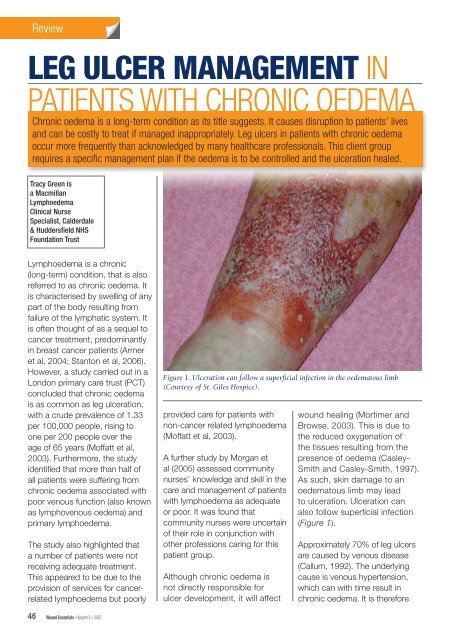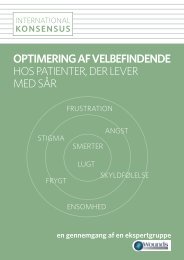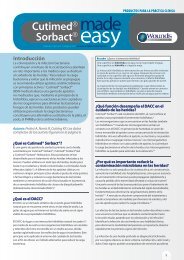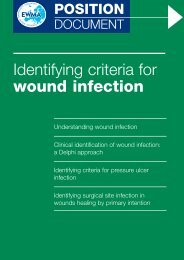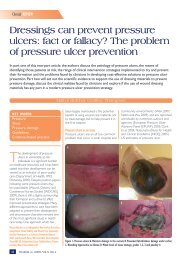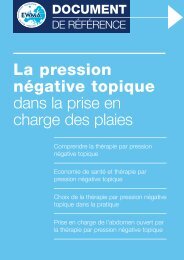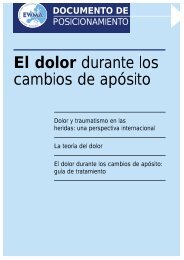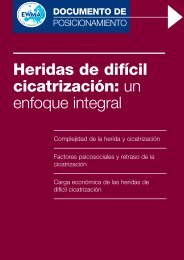leg ulcer management in patients with chronic oedema - Wounds ...
leg ulcer management in patients with chronic oedema - Wounds ...
leg ulcer management in patients with chronic oedema - Wounds ...
Create successful ePaper yourself
Turn your PDF publications into a flip-book with our unique Google optimized e-Paper software.
ReviewLEG ULCER MANAGEMENT INPATIENTS WITH CHRONIC OEDEMAChronic <strong>oedema</strong> is a long-term condition as its title suggests. It causes disruption to <strong>patients</strong>’ livesand can be costly to treat if managed <strong>in</strong>appropriately. Leg <strong>ulcer</strong>s <strong>in</strong> <strong>patients</strong> <strong>with</strong> <strong>chronic</strong> <strong>oedema</strong>occur more frequently than acknowledged by many healthcare professionals. This client grouprequires a specifi c <strong>management</strong> plan if the <strong>oedema</strong> is to be controlled and the <strong>ulcer</strong>ation healed.Tracy Green isa MacmillanLymph<strong>oedema</strong>Cl<strong>in</strong>ical NurseSpecialist, Calderdale& Huddersfield NHSFoundation TrustLymph<strong>oedema</strong> is a <strong>chronic</strong>(long-term) condition, that is alsoreferred to as <strong>chronic</strong> <strong>oedema</strong>. Itis characterised by swell<strong>in</strong>g of anypart of the body result<strong>in</strong>g fromfailure of the lymphatic system. Itis often thought of as a sequel tocancer treatment, predom<strong>in</strong>antly<strong>in</strong> breast cancer <strong>patients</strong> (Armeret al, 2004; Stanton et al, 2006).However, a study carried out <strong>in</strong> aLondon primary care trust (PCT)concluded that <strong>chronic</strong> <strong>oedema</strong>is as common as <strong>leg</strong> <strong>ulcer</strong>ation,<strong>with</strong> a crude prevalence of 1.33per 100,000 people, ris<strong>in</strong>g toone per 200 people over theage of 65 years (Moffatt et al,2003). Furthermore, the studyidentifi ed that more than half ofall <strong>patients</strong> were suffer<strong>in</strong>g from<strong>chronic</strong> <strong>oedema</strong> associated <strong>with</strong>poor venous function (also knownas lymphovenous <strong>oedema</strong>) andprimary lymph<strong>oedema</strong>.The study also highlighted thata number of <strong>patients</strong> were notreceiv<strong>in</strong>g adequate treatment.This appeared to be due to theprovision of services for cancerrelatedlymph<strong>oedema</strong> but poorlyFigure 1. Ulceration can follow a superficial <strong>in</strong>fection <strong>in</strong> the <strong>oedema</strong>tous limb(Courtesy of St. Giles Hospice).provided care for <strong>patients</strong> <strong>with</strong>non-cancer related lymph<strong>oedema</strong>(Moffatt et al, 2003).A further study by Morgan etal (2005) assessed communitynurses’ knowledge and skill <strong>in</strong> thecare and <strong>management</strong> of <strong>patients</strong><strong>with</strong> lymph<strong>oedema</strong> as adequateor poor. It was found thatcommunity nurses were uncerta<strong>in</strong>of their role <strong>in</strong> conjunction <strong>with</strong>other professions car<strong>in</strong>g for thispatient group.Although <strong>chronic</strong> <strong>oedema</strong> isnot directly responsible for<strong>ulcer</strong> development, it will affectwound heal<strong>in</strong>g (Mortimer andBrowse, 2003). This is due tothe reduced oxygenation ofthe tissues result<strong>in</strong>g from thepresence of <strong>oedema</strong> (Casley-Smith and Casley-Smith, 1997).As such, sk<strong>in</strong> damage to an<strong>oedema</strong>tous limb may leadto <strong>ulcer</strong>ation. Ulceration canalso follow superfi cial <strong>in</strong>fection(Figure 1).Approximately 70% of <strong>leg</strong> <strong>ulcer</strong>sare caused by venous disease(Callum, 1992). The underly<strong>in</strong>gcause is venous hypertension,which can <strong>with</strong> time result <strong>in</strong><strong>chronic</strong> <strong>oedema</strong>. It is therefore46 Wound Essentials • Volume 2 • 2007
Reviewlikely that <strong>patients</strong> <strong>with</strong> co-exist<strong>in</strong>g<strong>oedema</strong> and <strong>leg</strong> <strong>ulcer</strong>s, eitheras a result of trauma or venousdisease, will be encounteredfrequently <strong>in</strong> practice.This article aims to promoterecognition of <strong>chronic</strong> <strong>oedema</strong>and lymph<strong>oedema</strong> <strong>in</strong> <strong>patients</strong><strong>with</strong> <strong>leg</strong> <strong>ulcer</strong>ation, and willdiscuss what implications thediagnosis of <strong>chronic</strong> <strong>oedema</strong> willhave on the <strong>management</strong> of thepatient <strong>with</strong> <strong>leg</strong> <strong>ulcer</strong>s.The lymphatic systemThe lymphatic system has animportant role <strong>in</strong> ma<strong>in</strong>ta<strong>in</strong><strong>in</strong>gfluid balance. It carries fluid, fatsand prote<strong>in</strong>s back to the generalcirculation from the tissues thatwould otherwise accumulateas <strong>oedema</strong>. It also providesan important immunologicalfunction (Levick and Mortimer,2003), carry<strong>in</strong>g immune cellssuch as lymphocytes andmacrophages to the lymphnodes (Mortimer, 2000).Circulat<strong>in</strong>g blood carries fluidand nutrients to the bodytissues. As blood passesthrough the capillaries, fluidleaks out through the semipermeablewalls (filtration) and<strong>in</strong>to the <strong>in</strong>terstitial space thatlies between the capillary walland the tissues.The exchange of nutrients,wastes, fluid, electrolytes, andprote<strong>in</strong>s from the vascular andlymphatic systems and tissuecells occurs through this space.In this area, pressure may below and attract fluid <strong>in</strong>to thetissue, or an <strong>in</strong>crease <strong>in</strong> tissuepressure forces fluid <strong>in</strong>to the<strong>in</strong>itial lymphatics and capillaries.It is <strong>in</strong> the <strong>in</strong>terstitial fluid spacethat the forces result<strong>in</strong>g <strong>in</strong><strong>oedema</strong> come <strong>in</strong>to effect.Evidence has shown that themajority of <strong>in</strong>terstitial fluid isreturned to the blood circulationvia the lymphatic system andnot, as <strong>in</strong>itially thought, byabsorption directly <strong>in</strong>to venouscapillaries (Mortimer andLevick, 2004). The absorptionof <strong>in</strong>terstitial fluid is the crucialrole of the lymphatic system <strong>in</strong>ma<strong>in</strong>ta<strong>in</strong><strong>in</strong>g fluid balance. Whenthe lymphatic system is unableto ma<strong>in</strong>ta<strong>in</strong> this role, <strong>oedema</strong>occurs.Lymph<strong>oedema</strong>Lymph<strong>oedema</strong> is def<strong>in</strong>ed asswell<strong>in</strong>g of a limb or part ofthe body due to failure of thelymphatic system. It resultsprimarily when the lymphdra<strong>in</strong>age system fails toadequately dra<strong>in</strong> fluid from the<strong>in</strong>terstitial spaces. This failureleads to an accumulation offluid and prote<strong>in</strong>s <strong>in</strong> the tissues,result<strong>in</strong>g <strong>in</strong> swell<strong>in</strong>g or <strong>oedema</strong>.It can affect any part of the bodybut usually affects the limbs and/or the adjacent quadrant of thebody (Board and Harlow, 2002).Lymph<strong>oedema</strong> is classified asprimary or secondary. Primarylymph<strong>oedema</strong> is due to an<strong>in</strong>tr<strong>in</strong>sic abnormality of thelymphatic system. It may becaused by <strong>in</strong>sufficient numbersof lymphatic collectors (result<strong>in</strong>g<strong>in</strong> aplasia or hypoplasia). Itmay result from an abnormalityof the lymphatic vessels suchas hyperplasia or valvular<strong>in</strong>competence (Mortimer, 1998).It may be congenital (present atbirth but not hereditary), or candevelop at puberty or any agethereafter.Secondary lymph<strong>oedema</strong> isdue to damage or long-termoverload of the lymphaticsystem by extr<strong>in</strong>sic factors<strong>in</strong>clud<strong>in</strong>g:8Cancer treatment, e.g.surgery and/or radiotherapy8Recurrent <strong>in</strong>fection8Trauma8Parasitic <strong>in</strong>fection8Obstruction by tumour8Immobility8Venous disease, which will bedescribed now <strong>in</strong> more detail.Lymphovenous <strong>oedema</strong>Lymphovenous <strong>oedema</strong>occurs when <strong>chronic</strong> venousdisease associated <strong>with</strong> deepve<strong>in</strong> thrombosis, venoushypertension and <strong>chronic</strong> <strong>leg</strong><strong>ulcer</strong>ation <strong>in</strong>fluences capillarypermeability and <strong>in</strong>creasescapillary filtration rates.Venous hypertension is causedby failure of the calf musclepump to return blood back upthe <strong>leg</strong>. Incompetent valves<strong>in</strong> the deep, perforat<strong>in</strong>g orsuperficial ve<strong>in</strong>s lead to thebackflow of blood and theve<strong>in</strong>s elongate and becometortuous. The result<strong>in</strong>g <strong>in</strong>crease<strong>in</strong> pressure leads to leakageof blood particles and fluid<strong>in</strong>to the tissues. This is usuallycompensated for by a healthylymphatic system.However, a susta<strong>in</strong>ed <strong>in</strong>crease<strong>in</strong> capillary filtration leads toan overload of the lymphaticsystem, which will ultimatelyresult <strong>in</strong> <strong>oedema</strong>. Thus, acomb<strong>in</strong>ed lymphatic andvenous <strong>oedema</strong> results;lymphovenous <strong>oedema</strong>. Aslymphatic dra<strong>in</strong>age becomesfurther compromised,lymphostatic fibrosis beg<strong>in</strong>s toWound Essentials • Volume 2 • 2007 47
Reviewa swollen foot or toes, <strong>in</strong>creasedexudate from an <strong>ulcer</strong> site or apoorly heal<strong>in</strong>g wound may besigns that <strong>oedema</strong> is not be<strong>in</strong>gadequately controlled (Figure 3).Figure 2. Ulceration and maceration of the surround<strong>in</strong>g sk<strong>in</strong> and <strong>oedema</strong> around the<strong>ulcer</strong>.Figure 3. Swollen toes (Courtesy of St. Giles Hospice).develop lead<strong>in</strong>g to a <strong>chronic</strong><strong>oedema</strong> (Green and Mason,2006).Table 1Visible signs of long-term <strong>oedema</strong> <strong>in</strong> the lower limb8Positive Stemmer’s sign (Figure 6)8Dry, flaky sk<strong>in</strong>8Sk<strong>in</strong> creases around the ankles and toes (Figure 7)8Hyperkeratosis (Figure 7)8Lymphangioma8Papillomatosis8Increased subcutaneous fat.Chronic <strong>oedema</strong> ischaracterised as a longstand<strong>in</strong>g<strong>oedema</strong> that hasbeen present for at least threemonths and does not reduceon elevation of the affectedpart of the body (Green andMason, 2006). With cont<strong>in</strong>uedfluid accumulation, sk<strong>in</strong> andtissue changes occur (Table1). Chronic <strong>oedema</strong> has beenshown to affect a significantnumber of <strong>patients</strong> <strong>with</strong> <strong>leg</strong><strong>ulcer</strong>ation (Moffatt et al, 2004).In such <strong>patients</strong>, impairedlymphatic dra<strong>in</strong>age may beidentified around the <strong>ulcer</strong> siteby the presence of <strong>oedema</strong> andlocalised swell<strong>in</strong>g at the <strong>ulcer</strong>edge (Figure 2). The presence ofRecognis<strong>in</strong>g <strong>chronic</strong> <strong>oedema</strong>A thorough assessment of thepatient will help to identify riskfactors for the development of<strong>chronic</strong> <strong>oedema</strong> and aid <strong>in</strong> itsdiagnosis. A careful history andexam<strong>in</strong>ation should be carriedout to <strong>in</strong>clude:8General medical history,<strong>in</strong>clud<strong>in</strong>g identification ofconditions that may affectthe outcome of treatmentsuch as a history of venous<strong>in</strong>sufficiency, deep ve<strong>in</strong>thrombosis and cardiachistory8Limb volume measurement toassess the degree of swell<strong>in</strong>g8Assessment of the sk<strong>in</strong> andtissues to identify changesassociated <strong>with</strong> <strong>chronic</strong><strong>oedema</strong>, not<strong>in</strong>g factors thatmight affect the outcome oftreatment, such as repeatedepisodes of cellulitis, fungal<strong>in</strong>fections, papillomatosis,and sk<strong>in</strong> allergies, such asdermatitis8Psychosocial assessment todeterm<strong>in</strong>e the impact of theswell<strong>in</strong>g on the patient8Circulatory assessment— ankle brachial pressure<strong>in</strong>dex (ABPI) or toe brachialpressure <strong>in</strong>dex (TBPI). AnABPI must be calculated toexclude significant arterialdisease. An ABPI must begreater than 0.8 before highcompression can be applied.If below 0.8 refer for furthervascular <strong>in</strong>vestigations(Stevens, 2004) beforeundergo<strong>in</strong>g compressiontherapy.48 Wound Essentials • Volume 2 • 2007
ReviewManagement of<strong>chronic</strong> odemaLymph<strong>oedema</strong> <strong>management</strong>comprises four componentsused <strong>in</strong> comb<strong>in</strong>ation to providethe most effective reductionand ma<strong>in</strong>tenance of swell<strong>in</strong>g.The British Lymphology Society(BLS) recommends a m<strong>in</strong>imumstandard of care for <strong>patients</strong><strong>with</strong> lymph<strong>oedema</strong> (Figure 4).Patients who require an<strong>in</strong>tensive (decongestive) <strong>oedema</strong>treatment, i.e. those <strong>patients</strong><strong>with</strong> large, swollen, distortedlimbs <strong>with</strong> sk<strong>in</strong> problems, wouldusually be treated <strong>with</strong> a courseof multilayer lymph<strong>oedema</strong>bandag<strong>in</strong>g (MLLB) and possiblymanual lymphatic dra<strong>in</strong>age (MLD),along <strong>with</strong> sk<strong>in</strong> care, an exerciseprogramme, psychosocialsupport and education. This<strong>in</strong>tensive therapy programmeis used to ‘decongest’ the limband/or trunkal region by remov<strong>in</strong>gfl uid from the congested tissues,encourag<strong>in</strong>g the movementof fl uid through the lymphaticpathways and reshap<strong>in</strong>g the<strong>oedema</strong>tous limb.MLLB comprises of toebandag<strong>in</strong>g (Figure 5), tubularstock<strong>in</strong>ette, padd<strong>in</strong>g (us<strong>in</strong>geither soft bandage padd<strong>in</strong>g orpadd<strong>in</strong>g <strong>with</strong> foam) and layersof short-stretch bandages. Thebandages are usually appliedto the whole <strong>leg</strong> (toe to thigh)to prevent displacement of<strong>oedema</strong> <strong>in</strong>to these areas.This system provides a rigid‘structure’ around the limb andprovides low rest<strong>in</strong>g pressuresand high work<strong>in</strong>g pressures.Low rest<strong>in</strong>g pressure meansthat the bandage appliesconstant low pressure to thesk<strong>in</strong> when the limb is at rest.Sk<strong>in</strong> careMoisturisation/hydration ofthe sk<strong>in</strong>Ma<strong>in</strong>ta<strong>in</strong> sk<strong>in</strong> <strong>in</strong>tegrityPrevent <strong>in</strong>fectionCompression therapyMultilayer lymph<strong>oedema</strong>bandag<strong>in</strong>g (MLLB)Compression hosieryLymph<strong>oedema</strong>AssessmentSupportMonitor<strong>in</strong>gFigure 4. Four components of lymph<strong>oedema</strong> <strong>management</strong>(Adapted from BLS, 2002).Figure 5. Toe bandag<strong>in</strong>g.ExerciseMa<strong>in</strong>ta<strong>in</strong> jo<strong>in</strong>t mobilityEnhance lymphatic andvenous fl owLymphatic dra<strong>in</strong>ageManual lymphatic dra<strong>in</strong>ageSimple lymphatic dra<strong>in</strong>age50 Wound Essentials • Volume 2 • 2007
ReviewFigure 6. Positive Stemmer’s sign.When the muscles contract andexpand (e.g. dur<strong>in</strong>g exercise)they press aga<strong>in</strong>st the bandageand the pressure <strong>in</strong> the limbtemporarily <strong>in</strong>creases. This<strong>in</strong>creased ‘work<strong>in</strong>g’ pressurestimulates lymphatic pump<strong>in</strong>gand reabsorption of lymph(Moffatt, 2000).Management of <strong>leg</strong> <strong>ulcer</strong>sA graduated, susta<strong>in</strong>edcompression therapy istraditionally used <strong>in</strong> the<strong>management</strong> of <strong>leg</strong> <strong>ulcer</strong>s, <strong>with</strong>a wound dress<strong>in</strong>g selected asappropriate for the specificwound. A layered bandag<strong>in</strong>gsystem is used and is said tobe more effective than s<strong>in</strong>glelayer systems (Fletcher et al,1997). These systems are onlyapplied below the knee anddo not <strong>in</strong>clude the toes. Thebandages are left <strong>in</strong> situ forup to one week. The choiceof dress<strong>in</strong>g and bandag<strong>in</strong>gsystem will depend upon thepatient’s condition, assessmentand patient choice (Dowsett,2005).Management of <strong>leg</strong> <strong>ulcer</strong>sand <strong>chronic</strong> <strong>oedema</strong>: whichbandag<strong>in</strong>g system?Patients <strong>with</strong> <strong>chronic</strong> <strong>oedema</strong>and <strong>ulcer</strong>ation require a differentapproach to treatment thanthose <strong>with</strong> venous <strong>ulcer</strong>ationalone. The specific issuesassociated <strong>with</strong> manag<strong>in</strong>g thepatient <strong>with</strong> lymph<strong>oedema</strong>tous<strong>ulcer</strong>ation <strong>in</strong>clude:8Limb shape distortion8Care of sk<strong>in</strong> creases and folds8Swell<strong>in</strong>g of the toesand forefoot.These issues require a modifiedapproach to the usual venous<strong>leg</strong> <strong>ulcer</strong> bandag<strong>in</strong>g regimens(Moffatt et al, 2005).Patients <strong>with</strong> limb distortionand sk<strong>in</strong> folds or creases willrequire a more specialisedapproach to their careand, if available, work<strong>in</strong>g<strong>in</strong> conjunction <strong>with</strong> alymph<strong>oedema</strong> specialist serviceis useful. The use of padd<strong>in</strong>gor foams is needed to correctthe limb shape, pad out thesk<strong>in</strong> creases and even out thebandage shape to ensure thelimb reta<strong>in</strong>s a cyl<strong>in</strong>drical shape<strong>in</strong> order to ma<strong>in</strong>ta<strong>in</strong> the correctcompression gradient(Todd, 2000).In many cases where traditionalvenous <strong>leg</strong> <strong>ulcer</strong> bandag<strong>in</strong>g isused for <strong>patients</strong> <strong>with</strong> <strong>chronic</strong><strong>oedema</strong>, <strong>oedema</strong> of the toesand forefoot develops. Oedemaof the toes occurs when thebandages cause pressure onthe dorsum of the foot, push<strong>in</strong>gfluid down <strong>in</strong>to the toes. Wherevenous <strong>leg</strong> <strong>ulcer</strong> bandages havenot been applied far enoughdown the foot, dorsal swell<strong>in</strong>gmay occur. If the lymphatics<strong>in</strong> this area become stagnant,secondary sk<strong>in</strong> changes maytake place (Tiwari, 2003), suchas a positive Stemmer’s sign(Figure 6), thickened sk<strong>in</strong>, orpapillomatosis.It has been suggested thattraditional venous <strong>ulcer</strong>bandag<strong>in</strong>g systems used for<strong>patients</strong> <strong>with</strong> <strong>chronic</strong> <strong>oedema</strong>may result <strong>in</strong> persistent <strong>oedema</strong>of the toes, knees and thighs,exacerbat<strong>in</strong>g <strong>ulcer</strong>ation andprevent<strong>in</strong>g heal<strong>in</strong>g (Williams,2003). ‘Slippage’ of thebandage due to a reduction <strong>in</strong>swell<strong>in</strong>g, particularly <strong>in</strong> the earlydays of treatment can lead to atourniquet effect and can causefurther distortion <strong>in</strong> the shapeof the limb. Hence, MLLB maybe more appropriate for thispatient group.Components of sk<strong>in</strong> careSk<strong>in</strong> careCare of the sk<strong>in</strong> is a majorconcern when manag<strong>in</strong>g<strong>patients</strong> <strong>with</strong> <strong>ulcer</strong>ation52 Wound Essentials • Volume 2 • 2007
ReviewFigure 8. Lymphorrhoea. (Courtesy of St.Giles Hospice).Figure 7. Hyperkeratosis and sk<strong>in</strong> creases (courtesy of St Giles Hospice).and <strong>oedema</strong>. Patients <strong>with</strong><strong>chronic</strong> <strong>oedema</strong> are at an<strong>in</strong>creased risk of <strong>in</strong>fection ifthe sk<strong>in</strong> is dry and cracked.This can lead to cellulitis andfurther deterioration <strong>in</strong> their<strong>oedema</strong>. The sk<strong>in</strong> <strong>in</strong>tegrity ofthe unaffected sk<strong>in</strong> must bema<strong>in</strong>ta<strong>in</strong>ed. Moisturisation ofthe sk<strong>in</strong> is essential to ma<strong>in</strong>ta<strong>in</strong>its hydration. An appropriatedress<strong>in</strong>g should be used toprotect the sk<strong>in</strong> around thewound (peri-wound) frommaceration (breakdown causedby moisture), which can occurif excess fluid (exudate) fromthe wound is left <strong>in</strong> contact<strong>with</strong> the sk<strong>in</strong>. Consultation<strong>with</strong> tissue viability specialistwill be of benefit <strong>in</strong> <strong>patients</strong><strong>with</strong> complicated <strong>ulcer</strong>s.Referral should be made ifthere is any doubt concern<strong>in</strong>g<strong>management</strong>.Compression and supportCompression and supportare the foundations of good<strong>oedema</strong> <strong>management</strong> and canbe used to reduce swell<strong>in</strong>gand ma<strong>in</strong>ta<strong>in</strong> the reduction(BLS, 2002). Often describedas conta<strong>in</strong>ment (Todd,2000), external support <strong>in</strong>comb<strong>in</strong>ation <strong>with</strong> muscularactivity stimulates both venousand lymphatic dra<strong>in</strong>age. MLLBis recognised as an essentialcomponent of the <strong>in</strong>tensivephase of lymph<strong>oedema</strong><strong>management</strong> (Casley-Smithand Casley-Smith, 1997).In addition to the reductionof <strong>oedema</strong>, MLLB restoreslimb shape, reduces the riskof sk<strong>in</strong> changes and canhelp to soften subcutaneoustissues and support stretchedsk<strong>in</strong> (Williams, 2003). MLLBenhances lymph formationby <strong>in</strong>creas<strong>in</strong>g movement of<strong>in</strong>terstitial fluid <strong>in</strong>to the <strong>in</strong>itiallymphatics by <strong>in</strong>creas<strong>in</strong>g tissuepressure when the patientmoves (Leduc et al, 1990;Thomas, 1996; Casley-Smithand Casley-Smith 1997).MLLB is <strong>in</strong>dicated for <strong>patients</strong><strong>with</strong>:8Fragile/damaged or <strong>ulcer</strong>atedsk<strong>in</strong>8Fibrotic sk<strong>in</strong> changes, e.g.hyperkeratosis, papillomatosis8Lymphangioma8Lymphorrhoea (Figure 8)8Solid, non-pitt<strong>in</strong>g, fibroticsubcutaneous tissues8Sk<strong>in</strong> folds/creases.MLLB is contra<strong>in</strong>dicated for<strong>patients</strong> <strong>with</strong>:8Acute <strong>in</strong>fection, e.g. cellulitis8Arterial <strong>in</strong>sufficiency8Deep ve<strong>in</strong> thrombosis (DVT)8Severe cardiac failure.Components of the MLLBsystem such as padd<strong>in</strong>g,toe bandag<strong>in</strong>g and full <strong>leg</strong>bandag<strong>in</strong>g may be <strong>in</strong>corporated<strong>in</strong>to venous bandag<strong>in</strong>g systems,as they may help to reduce the<strong>oedema</strong> thereby enhanc<strong>in</strong>gheal<strong>in</strong>g by improv<strong>in</strong>g deliveryof nutrients to the cells andspeed<strong>in</strong>g up the removal ofwaste products (Williamsand Keller, 2005). However,bandag<strong>in</strong>g the full <strong>leg</strong> doesrequire some skill and the fourlayersystem may not lend itselfreadily to this technique dueto the high rest<strong>in</strong>g pressuresexerted by the bandages at theknee jo<strong>in</strong>ts and thigh.Ideally, MLLB should bereapplied daily especially <strong>in</strong>the early stages of treatmentas the bandages may becomeloose or slip due to reduction<strong>in</strong> limb volume. However, asthe treatment cont<strong>in</strong>ues theuse of cohesive short-stretchbandages <strong>with</strong><strong>in</strong> the MLLBsystem can reduce slippage54 Wound Essentials • Volume 2 • 2007
Reviewand allow bandages to stay<strong>in</strong> place for longer (Williams,2006), thereby reduc<strong>in</strong>g nurs<strong>in</strong>gtime and frequency of dress<strong>in</strong>gchange.The choice of <strong>ulcer</strong> dress<strong>in</strong>gshould also be consideredto prevent sk<strong>in</strong> irritation andreaction. Us<strong>in</strong>g a tubularbandage over the dress<strong>in</strong>gand under the padd<strong>in</strong>g shouldhelp to reduce sk<strong>in</strong> reactionsand provide protection tothe tissues. Toe bandag<strong>in</strong>g<strong>in</strong> conjunction <strong>with</strong> venousbandag<strong>in</strong>g systems can help toreduce toe swell<strong>in</strong>g. However, itis also important that bandagesare applied from toe to knee<strong>with</strong> the correct technique toavoid forefoot swell<strong>in</strong>g.For immobile <strong>patients</strong>, acomb<strong>in</strong>ation of venousbandag<strong>in</strong>g that produces ahigher rest<strong>in</strong>g pressure may bemore useful than MLLB dueto the reduced muscle activity(Moffatt et al, 2005).For every patient, the cl<strong>in</strong>icianneeds to assess limb shape,tissue condition, and the extentof <strong>oedema</strong> <strong>in</strong> order to decidewhich bandage techniqueshould be used. If <strong>in</strong> doubt,<strong>management</strong> should bediscussed <strong>with</strong> a specialist.Exercise and movementMobility and exercise playan important role <strong>in</strong> the<strong>management</strong> of <strong>patients</strong> <strong>with</strong>lymph<strong>oedema</strong> and <strong>ulcer</strong>ation,especially if the patient isundergo<strong>in</strong>g MLLB. Movementcan improve lymph flow byenhanc<strong>in</strong>g the muscle pumpaction which has an effect onlymphatic and venous flow,thereby remov<strong>in</strong>g fluid from thetissues.Mortimer et al (1990) and Goodyet al (2001) suggest that passivemovement of the foot can causesignificant volume change <strong>in</strong> thelower limbs (Vaqas and Ryan,2003). Foot and ankle exercisesshould be encouraged topromote calf pump action andthigh and hip exercises can help<strong>with</strong> fluid movement from thethigh.Manual lymphatic dra<strong>in</strong>ageIn some cases it may beappropriate to <strong>in</strong>clude manuallymphatic dra<strong>in</strong>age (MLD) <strong>in</strong>the treatment plan of <strong>patients</strong><strong>with</strong> <strong>ulcer</strong>ation and <strong>chronic</strong><strong>oedema</strong>. Manual lymphaticdra<strong>in</strong>age is a type of massagewhich is designed to utilisethe sk<strong>in</strong> lymphatic dra<strong>in</strong>ageroutes to redirect fluid fromthe <strong>oedema</strong>tous regions toareas <strong>with</strong> healthy lymphatics.It requires specific gentlemovements on the sk<strong>in</strong> tostimulate lymph flow and openup collateral lymphatic vessels.This may accelerate andstabilise the treatment results(Strossenreuter, 2003). MLDmay also be performed onthe <strong>ulcer</strong> site. This will requirereferral to a lymph<strong>oedema</strong>specialist practitioner forappropriate treatment.A case study will now bepresented that demonstratesthe effective <strong>management</strong> ofa patient <strong>with</strong> lymphovenous<strong>oedema</strong> and <strong>leg</strong> <strong>ulcer</strong>ation.Case studyPatient X, a 45-year-old malehad significant sk<strong>in</strong> and muscleFigure 9. Ulcer heal<strong>in</strong>g after 2 weeks oftreatment.Figure 10. Compression hosiery wasused to ma<strong>in</strong>ta<strong>in</strong> limb volume reduction.loss <strong>in</strong> both thighs follow<strong>in</strong>g acrush <strong>in</strong>jury. He consequentlydeveloped lymph<strong>oedema</strong>of both <strong>leg</strong>s and underwenta course of decongestivelymphatic therapy to reducethe swell<strong>in</strong>g to his right <strong>leg</strong><strong>in</strong> 1999. Follow<strong>in</strong>g the useof compression hosiery onboth limbs, the swell<strong>in</strong>gwas conta<strong>in</strong>ed. In 2005he developed a deep ve<strong>in</strong>thrombosis (DVT) <strong>in</strong> his leftthigh and went on to developsymptoms of <strong>chronic</strong> venous<strong>in</strong>sufficiency <strong>in</strong> addition tolymph<strong>oedema</strong>. He developeda small <strong>ulcer</strong> to the medialaspect of the ankle abovethe mallelous of his left <strong>leg</strong>that was treated successfully.56 Wound Essentials • Volume 2 • 2007
ReviewUnfortunately, early <strong>in</strong> 2006 hedeveloped further <strong>ulcer</strong>ation tohis left limb. He was seen bya healthcare professional who<strong>in</strong>formed him that he could notreceive compression bandag<strong>in</strong>gbecause he had lymph<strong>oedema</strong>.At that po<strong>in</strong>t a hydrocolloiddress<strong>in</strong>g was applied to the<strong>ulcer</strong> site. Patient X was toldto remove the dress<strong>in</strong>g sevendays later and come back ifhe had further problems. Aftertwo days he was experienc<strong>in</strong>gexcruciat<strong>in</strong>g pa<strong>in</strong> at the<strong>ulcer</strong> site and contacted thelymph<strong>oedema</strong> service. Onassessment he had an <strong>ulcer</strong> tothe gaiter area of the left <strong>leg</strong> thatwas odorous and produc<strong>in</strong>gexudate. The sk<strong>in</strong> surround<strong>in</strong>gthe <strong>ulcer</strong> was macerated and<strong>in</strong>flamed.Patient X’s <strong>leg</strong> was <strong>oedema</strong>touson the foot and from mid-calfto thigh, but the ankle area was<strong>in</strong>durated and he had developeda typical ‘<strong>in</strong>verted champagnebottle’ appearance. This was aproblem because when normalvenous <strong>leg</strong> <strong>ulcer</strong> bandag<strong>in</strong>gwas applied, the shape of his<strong>leg</strong> caused the bandages to slipand further distort the shape ofhis lower <strong>leg</strong>.ABPI was normal and therewere no signs of arterial<strong>in</strong>sufficiency. A swab was takenfor micro-culture and sensitivity.A non-adhesive dress<strong>in</strong>g wasapplied to the <strong>ulcer</strong>. The limbwas bandaged us<strong>in</strong>g a modifiedmultilayer system compris<strong>in</strong>gtoe bandages, tubifast, softwool padd<strong>in</strong>g and cohesiveshort-stretch bandages. A full<strong>leg</strong> bandage was not appliedas Patient X had restrictedmovement <strong>in</strong> his right <strong>leg</strong>due to the rigidity of his kneefollow<strong>in</strong>g the accident. It wasimportant not to impede hismobility further by restrict<strong>in</strong>gthe movement <strong>in</strong> his left kneethrough bandage application. Itwas also necessary to pad outthe distorted shape at the ankleto avoid excessive pressure.The wound swab came backpositive for Staphylococcusaureus and Patient X wasprescribed flucloxacill<strong>in</strong>. Thedistrict nurses replaced hisbandages a few days later andhe returned to the cl<strong>in</strong>ic a weekafter his first appo<strong>in</strong>tment.There were already signs thatthe <strong>ulcer</strong> was heal<strong>in</strong>g and hehad not experienced any pa<strong>in</strong>s<strong>in</strong>ce hav<strong>in</strong>g the bandagesapplied. This treatment planwas cont<strong>in</strong>ued for a furthertwo weeks <strong>with</strong> the <strong>ulcer</strong>beg<strong>in</strong>n<strong>in</strong>g to heal very quickly(Figure 9). He was monitoredfor signs of swell<strong>in</strong>g to theknee or thigh and, after threeweeks, was fitted <strong>with</strong> custommadecompression hosiery toma<strong>in</strong>ta<strong>in</strong> limb volume reduction(Figure 10).ConclusionRecognition of <strong>chronic</strong> <strong>oedema</strong><strong>in</strong> <strong>patients</strong> <strong>with</strong> <strong>ulcer</strong>ationis essential if treatment isto be managed effectively.A comb<strong>in</strong>ed approach to<strong>management</strong> is essentialto facilitate successfuloutcomes for this client group.Assessment and correctdiagnosis is crucial to therecognition of lymph<strong>oedema</strong>.Referral to the lymph<strong>oedema</strong>specialist and/or tissue viabilityservices will benefit thepatient <strong>in</strong> the long-term andis an essential component ofmultidiscipl<strong>in</strong>ary teamwork.Key Po<strong>in</strong>ts8 Chronic <strong>oedema</strong> affects a significantproportion of the population.8 Chronic <strong>oedema</strong> and <strong>ulcer</strong>ationrequire a modified, succ<strong>in</strong>ctapproach to <strong>management</strong>.8 Thorough assessment of a<strong>chronic</strong>ally swollen limb is essentialif the appropriate treatment is to becarried out.Simple changes to bandag<strong>in</strong>gtechniques to address thelymphatic component ofswell<strong>in</strong>g can br<strong>in</strong>g about a quickresponse to treatment. Thisnot only improves the <strong>patients</strong>’quality of life but reduces thecosts of dress<strong>in</strong>gs and nurs<strong>in</strong>gtime (Stalbow, 2004). Leg <strong>ulcer</strong>practioners and lymph<strong>oedema</strong>services should adopt an<strong>in</strong>tegrated approach to meetthe needs of <strong>patients</strong> <strong>with</strong>lymph<strong>oedema</strong>/<strong>chronic</strong> <strong>oedema</strong>and <strong>leg</strong> <strong>ulcer</strong>s. WEArmer J, Fu MR, Wa<strong>in</strong>stockJH, Zagar E, Jacobs LK (2004)Lymph<strong>oedema</strong> follow<strong>in</strong>g breastcancer treatment, <strong>in</strong>clud<strong>in</strong>g sent<strong>in</strong>ellymph node biopsy. Lymphology37: 73–91Badger CM, Peacock JL,Mortimer PS (2000) Arandomised, controlled, parallelgroupcl<strong>in</strong>ical trial compar<strong>in</strong>gmultilayer bandag<strong>in</strong>g followedby hosiery versus hosiery alone<strong>in</strong> the treatment of <strong>patients</strong> <strong>with</strong>lymph<strong>oedema</strong> of the limb. Cancer88(12): 2832–7Board J, Harlow W (2002)Lymph<strong>oedema</strong> 1: components andfunction of the lymphatic system.Br J Nurs 11(5): 304–9Wound Essentials • Volume 2 • 2007 57
ReviewBoard J, Harlow W (2002)Lymph<strong>oedema</strong> 2: classification,signs, symptoms and diagnosis. BrJ Nurs 11(6): 389–95Board J, Harlow W (2002)Lymph<strong>oedema</strong> 3: the availabletreatments for lymph<strong>oedema</strong>. Br JNurs 11(7): 438–50British Lymphology Society (2002)Strategy for Lymph<strong>oedema</strong>Management. BLS, Sevenoaks, KentCallum M (1992) Prevalence of<strong>chronic</strong> <strong>leg</strong> <strong>ulcer</strong>ation and severe<strong>chronic</strong> venous disease <strong>in</strong> westerncountries. Phlebology 1 (suppl): 6–12Casley-Smith J, Casley-SmithJR (1997) Modern Treatment forLymph<strong>oedema</strong>. 5th edn. TerracePr<strong>in</strong>t<strong>in</strong>g, Adelaide, AustraliaDowsett C (2005) Assessment and<strong>management</strong> of <strong>patients</strong> <strong>with</strong> <strong>leg</strong><strong>ulcer</strong>s. Nurs Stand 19(32): 65–72Fletcher A, Cullum N, SheldonTA (1997) A systematic review ofcompression treatment for venous<strong>leg</strong> <strong>ulcer</strong>s. Br Med J 315(7108):576–80Godoy JMP, Godoy MFG (2001)Development and evaluation of anapparatus for lymph dra<strong>in</strong>age. Eur JLymphology 9: 121Green T, Mason W (2006) Chronic<strong>oedema</strong>s: identification and referralpathways. Br J Comm Nurs 11(4):S8–S16Leduc A et al (1990) Le traitementPhysique de l’oedeme du bras.Monographies de Bois-larris, 2ndedn. Masson, ParisLevick JR, McHale N (2003) Thephysiology of lymph production andpropulsion In: Browse N, BurnandKG, Mortimer PS, eds. Diseases ofthe Lymphatics. Arnold, London:44–64Moffatt CJ (2000) CompressionTherapy. J Community Nurs 14:26–36Moffatt CJ, Franks PJ, DohertyDC et al (2003) Lymph<strong>oedema</strong>: anunderestimated health problem.QJM 96(10): 731–8Moffatt CJ, Franks PJ, Doherty DC,Mart<strong>in</strong> R, Blewett R, Ross F (2004)Prevalence of <strong>leg</strong> <strong>ulcer</strong>ation <strong>in</strong> aLondon population. QJM 97(7):431–7Moffatt CJ, Morgan P, DohertyD (2005) The Lymph<strong>oedema</strong>Framework: a consensus onlymph<strong>oedema</strong> bandag<strong>in</strong>g. In:European Wound ManagementAssociation (EWMA) FocusDocument: Lymph<strong>oedema</strong>Bandag<strong>in</strong>g <strong>in</strong> Practice. MEP Ltd,LondonMoffatt CJ, Franks PJ, Doherty DC,Mart<strong>in</strong> R (2004) Prevalence of <strong>leg</strong><strong>ulcer</strong>ation <strong>in</strong> a London population.QJM 97: 431–7Morgan PA, Moody M, Franks PJ,Moffatt CJ, Doherty DC (2005)Assess<strong>in</strong>g community nurses’ levelof knowledge of lymph<strong>oedema</strong>. BrJ Nurs 14(1): 8–13Mortimer PS (1998) Thepathophysiology of lymph<strong>oedema</strong>.Cancer (suppl) 83(12): 2798–802Mortimer P (2000) AcuteInflammatory Episodes In: TywcrossR, Jenns K, Todd J, eds (2000)Lymph<strong>oedema</strong>. Radcliffe MedicalPress. Oxon: 130–9Mortimer P, Browse N (2003)The relationship between thelymphatics and <strong>chronic</strong> venousdisease. In: Browse N, BurnandKG, Mortimer PS (2003) Diseasesof the Lymphatics. Arnold, London:293–6Mortimer PS, Levick JR (2004)Chronic peripheral <strong>oedema</strong>: thecritical role of the lymphatic system.Cl<strong>in</strong> Med 4(5): 448–53Mortimer PS, Simmonds R, RezvaniM, Robb<strong>in</strong>s M, Hopewell JW,Ryan T (1990) The measurementof skl<strong>in</strong> lymph flow by isotopeclearance-reliability, reproducibility,<strong>in</strong>jection dynamics and the effectof massage. J Invest Dermatol 95:677–82Stalbow J (2004) Prevent<strong>in</strong>gcellulitis <strong>in</strong> older people <strong>with</strong>persistent lower limb <strong>oedema</strong>. Br JNurs 13(12): 725–32Stanton A, Modi S, Mellor S,Levick R, Mortimer P (2006)Diagnos<strong>in</strong>g breast cancer-relatedlymph<strong>oedema</strong> <strong>in</strong> the arm. JLymph<strong>oedema</strong> 1(1): 12–15Stevens J (2004) Diagnosis,assessment and <strong>management</strong>of mixed aetiology <strong>ulcer</strong>s us<strong>in</strong>greduced compression. J WoundCare 13(8): 339–43Strossenreuter RHK (2003)Practical <strong>in</strong>structions fortherapists-general requirements forcompression bandages. In: FoldiM, Foldi E, Kubik S (eds) Textbookof Lymphology for Physicians andLymph<strong>oedema</strong> Therapists. Urbanand Fischer, San Francisco: 564–7Thomas S (1996) High compressionbandages. J Wound Care 5: 40–3Tiwari A, Cheng, KS, Button Met al (2003) Differential diagnosis,<strong>in</strong>vestigation and current treatmentof lower limb lymph<strong>oedema</strong>. ArchSurg 138(2): 152–61Todd J (2000) Conta<strong>in</strong>ment <strong>in</strong> the<strong>management</strong> of lymph<strong>oedema</strong>. In:Tywcross R, Jenns J, Todd J, eds.Lymph<strong>oedema</strong>. Radcliffe MedicalPress, OxfordVaqas B, Ryan TJ (2003)Lymph<strong>oedema</strong>: Pathophysiologyand <strong>management</strong> <strong>in</strong> resource-poorsett<strong>in</strong>gs — relevance for lymphaticfilariasis control programmes. FilariaJ 2(1): 4Williams AF (2003) The<strong>management</strong> of lymph<strong>oedema</strong>of the lower limbs. J Comm Nurs17(8): 34–44Williams AF, Keller M (2005)Practical guidance onlymph<strong>oedema</strong> bandag<strong>in</strong>g ofthe upper and lower limbs. In:European Wound ManagementAssociation (EWMA). FocusDocument: Lymph<strong>oedema</strong>Bandag<strong>in</strong>g <strong>in</strong> Practice. MEP Ltd,LondonWilliams A (2006) A cl<strong>in</strong>ical auditof Actico cohesive short stretchbandages <strong>in</strong> lymph<strong>oedema</strong>. JComm Nurs 20(2): 4–858 Wound Essentials • Volume 2 • 2007


